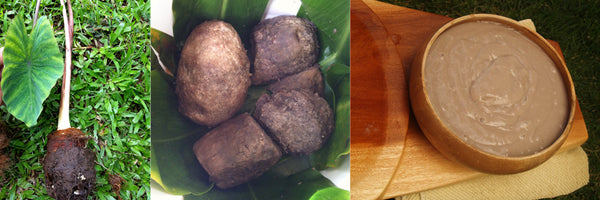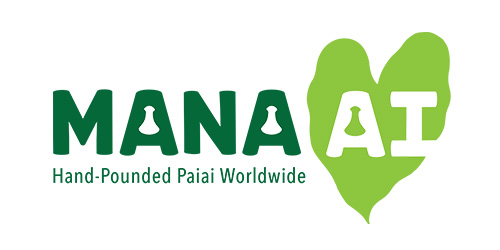The Happenings
I Am Hāloa January 23 2014, 0 Comments
**ONE HOUR TO COMPLETE KICKSTARTER CHALLENGE**
Go to www.iamhaloa.org now and show your support for a great cause!
A feature length documentary about the staple food of Hawai'i; Kalo (taro) and it's connection to Hawai'i's culture.

I am Hāloa is a feature length documentary film about Hawaiian identity and culture, as understood through the story of Hāloa, the first Hawaiian person in the Hawaiian Creation Story known as the Kumulipo, and the traditional Hawaiian staple food commonly known as poi. This film tells the story of three Kamehameha high school seniors who are embarking on a journey of self-discovery as they travel throughout the Hawaiian Islands to gain a better understanding of their culture and to re-establish a link to the first Hawaiian, Hāloa. For 90 days they will commit to cultivating, harvesting and eating kalo (taro) for three meals a day. During these 90 days the girls will travel from Oʻahu to Kauaʻi, Maui, Molokaʻi, Moku o Keawe, Kahoʻolawe, and Lānaʻi to learn from some of the most inspirational leaders in Hawaiʻi about the past, the present and the future role that Hāloa could play in guiding the people of Hawaiʻi. I am Hāloa will explore the inherent values and conflicts that come with incorporating Hāloa into modern lifestyles and also the amazingly delicious new ways that this ancient, sacred food is revolutionizing cuisine in Hawaiʻi. These three young ladies will work with some of the top chefs in Hawaiʻi like Lee Anne Wong, Ed Kenney, Mark Noguchi and Andrew Le, to see how Hāloa is being incorporated into the menus of the most delicious restaurants in Hawaii.
Visit www.iamhaloa.org for more information about how you can help!

Wanted: Kanaka Ku'i'ai November 15 2013, 0 Comments

We will be filming a Ku'i 'Ai Flash Mob on Sunday, 11/17 from 2p.m-7p.m. in Waikiki. The goal is to create a fundraising video for a new film project involving 3 young women on the search for Haloa.
Price of Paiai October 18 2013, 1 Comment
In the below entry, we’ll explain the difference in pricing and quality between our paiai and store-bought poi. Store-bought poi averages between $6 and $8 per pound. This stands in stark contrast to the $25 per pound for our paiai. We’ll help you understand why our product is priced what it is and what you’re getting for $25 per pound.Store-bought poi has a taro content of no less than 28% (Department of Health). This means that for a single pound of poi you are getting a little less than 1/3 of a pound of actual taro. Conversely, in 1943, poi with a taro content of less than 30% was deemed unfit for consumption (County of Hawaii). So, how did 30% become the norm?
Well, the price of taro isn’t all that expensive – the large taro mills pay on average 67¢ per pound. What has changed is the volume of production. In 1900, it is estimated, there were just over 1,200 acres of taro in production. Today, there remain less than 400 acres of taro. That’s a more than 60% reduction in taro available. Less taro equates to less taro in your poi.
Our paiai is hand-pounded – not milled through a machine – using the least amount of water and containing a taro content of between 95% and 99%. But this still leaves us with a $25 product. So what gives?
Well, paiai is *not* poi. Poi is diluted paiai. After pounding paiai, it is mixed into poi by adding water. One pound of our paiai mixes three pounds of one-finger poi. If we were to mix our paiai into the same consistency as store-bought poi, we would have around four pounds. So, let’s do the math.
One pound of paiai costs $25. One pound of store-bought poi costs $6 – we’ll go with the low figure. Comfortably mixing our paiai into three-and-a-half pounds, that comes out to $7.14. For a dollar and change more you get a hand-made product. Now let’s turn to taro quality.
The taro mills use an improvised mochi machine to process taro into poi. To do this, they use overripe taro for two reasons: firstly, once past maturation, the huluhulu, the roots, of the taro have atrophied making it easier to harvest; and secondly, overripe taro won’t wear down a mill.
Taro is deemed overripe, or loliloli, because of its low starch and high sugar and water content. The same taro would be difficult, if not impossible to kui. Our taro, however, is pulled just as the corms begin to ripen, maximizing starch content and minimizing loliloli kalo, which is why we purchase only the highest quality taro for no less than $2.00 per pound. Varieties we comfortably work with, like kai or apii or moi or pololu, would ravage a poi mill. It is too thick for a machine to process into poi, under current capabilities. And for anyone who’s had paiai, there is simply no replacement, no substitute for the thick, gummy, mochi-like consistency.
So, we make no claims that our taro is of higher quality or more that our poi is more cost-effective for the consumer, because as Uncle Jerry Konanui says, no taro is better than another – it all depends on the mahiai, the farmers, who malama them. We invite you, though, to open your umeke, fill it with our poi, scoop a mouthful and decide for yourself. No hookano. Just ai. E ola Haloa.
~ Trevor
References
Department of Health, title 11, ch. 29, §11-29-6 Poi.http://gen.doh.hawaii.gov/sites/har/admrules1/11-29.pdf.
County of Hawaii, ordinance no. 131, sec. 4. An Ordinance Regulating Poi Shop. http://records.co.hawaii.hi.us/Weblink8/DocView.aspx?id=58110&searchid=8078b84a-6fce-4b0c-90c7-de3d361a45d5&dbid=0.
Free Paiai!!! October 09 2013, 0 Comments
Just in case you haven't heard, we'll be running our very first Mana Ai Paiai Photo Contest. Submit your photos of anything Mana Ai-related – pohaku, paiai, us at a show, kui kalo – at our Mana Ai Paʻiʻai Facebook page and at the end of the month (Oct. 31), the photo that has received the most "likes" will win a month's supply* of fresh, hand-pounded paiai free. It's that simple. Be sure to include a caption of how the photo relates to Mana Ai and to hash-tag the photo #manaaipc. Don't forget to vote. Ready. Set. Go!*the winner will receive one pound of paiai per week for one month – a $100 value.
Moi Paiai Preparation October 07 2013, 2 Comments
Whether we’re at the annual Prince Lot Hula Festival or making some ai for Whole Foods, most people tend to think our process begins and ends at pounding. However, this is in fact one of the last stages of our process. The below video demonstrates the cleaning, care, and finally pounding of an absolutely optimal Moi taro from Waipio, moku o Keawe.
It all begins, of course, with our farmers from Kauai, Oahu, Maui, and moku o Keawe. After careful and steadfast stewardship, we cook it in industrial-grade pressure cookers to minimize direct contact with water. Then, we clean the taro. Finally, it is prepared by one of the Mana Ai poi-fessionals, pounded on one of our papa kuiai – poi-pounding boards – carved from local Kamani, Monkeypod, or Mango woods using one of our pohaku kuiai – poi-pounding stone – gathered from local streams and carved by hand.
Both of these instruments – papa and pohaku kuiai – are available for purchase through our nonprofit organization Hui Aloha Aina Momona (http://www.ainamomona.org/). We offer completed papa and pohaku and cured slabs should you choose to get your hands dirty carving a treasure that will last generations. Our only requirement in purchasing a papa and pohaku is that neither is used for display or collection purposes. Our tools are built to feed, to bring life to your family.
If you find you’re interested in taking a more proactive role in producing food for your family, you can call Daniel @ 808.542.1326 to see when completed papa and pohaku or cured slabs will next be available.
Gotta go! A hui hou.
~ Trevor
Become a Poi-fessor October 06 2013, 1 Comment
You had poi at last week's paina. Maybe you come out and kui with us. If you'd like to learn more about poi, check out the below video for an informative brief on the agricultural and cultural context of taro.
From the ancient times to the replacing of taro in households by rice, the crop has undoubtedly undergone several transformations since being brought over by the first people to immigrate to Hawaii thousands of years ago. Most notably, the recipe for making poi has evolved and changed as different ethnic groups in Hawaii interacted with taro. But one thing is certain, the crop has made great strides to make it back into your umeke and onto your plates.
In other news, we were at the Children’s and Youth Day at the State Capitol today. Big shout-out to the Kamehameha kui club, Hui Aloha Aina Olauniu, and everyone else who came out to support Hawaii’s children.
Gotta go! A hui hou.
~ Trevor
Fresh Beginnings August 26 2013, 1 Comment
Having now a new home for our website, complete with a state-of-the-art eCommerce function, we’ll be playing a little catch-up updating our blog materials. We promise to integrate all our information into one interface so that users may access our videos, articles, and profiles without having to scroll through a Google search, but it’ll take us some time.As the first post in what surely will be many, check out the video profile below of one of our partners, Daniel Anthony. Daniel, or Bruddah Daniel, fell in love with both taro and agriculture at an early age. He grew up on the Ohana Poe kuleana lands in Waianae, Oahu. These were some of the last kuleana lands in all of Waianae. It was there, under the tutelage of Tutu Man, knee-deep in the loi kalo – the wetland taro patch – that Daniel fell in love with mama aina and Haloa. He’s worked to translate this love into not only a small business but also a household philosophy governing all thoughts, all words, and all actions.
On Thursdays and Fridays, the Mana Ai boys get together to cook some taro. They gather around a few buckets and begin the process. They pohole. They ihi twice – the whole time talking story. And when they’ve enough to fill the weekly orders, they begin to kui. On these days the sound of the pohaku striking the ai and papa rings throughout the neighborhood, out to Waikalua loko ia, deep into ma uka. It’s a sound the pohaku, the aina, have heard for over 1000 years. We’re working to revive our bodies through our food and our aina through our work, because you can’t have ai without aina.
So, welcome to our new home. Order some paiai if you’d like. We just uploaded some pretty mean recipes that’ll guarantee fill your opu. We ship anywhere within the Continental U.S. If you’re on Oahu, we sell raw taro as well. If you have a question or concern you’d like to run by us, no shame reach out. In parting, check out our Throw to Grow profile below. Big shout-out to our wizard engineer Sara Phillips for building us an awesome website, and to Each One Teach One Farms and Nate Peracciny for producing one kickass video.
Gotta go! A hui hou.
~ Trevor
Throw To Grow Profile: Daniel Anthony Part 01 from nathan m peracciny on Vimeo.
